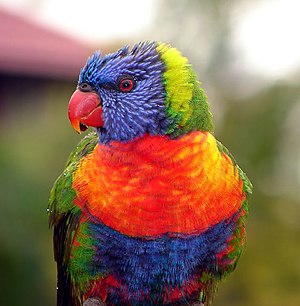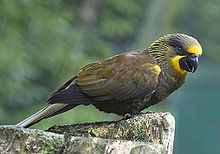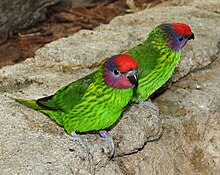Loris (parrots)
| Loris | ||||||||||||
|---|---|---|---|---|---|---|---|---|---|---|---|---|

Rainbow Lorikeet ( Trichoglossus haematodus ) |
||||||||||||
| Systematics | ||||||||||||
|
||||||||||||
| Scientific name | ||||||||||||
| Loriini | ||||||||||||
| Selby , 1836 |

The Loris (Loriini), more rarely, Lorie written or honey parrots called, are a nectar drinking tribe of the family of authentics Parrots (Psittacidae).
In addition, the tree-dwelling primates of the family Lorisidae or Loridae are also known as Loris . In order to avoid confusion, the spelling Lori e s is sometimes used for the birds (Loriinae) . In the singular and in the species name using a complete trivial name , it is called Lori in all cases.
Appearance
Loris are small to medium-sized, colorful, tree-dwelling parrots. Their plumage is dense and shiny. Green, red and blue tones dominate. A specialty is their diet. They feed mainly on pollen and nectar, but also on soft, juicy fruits . For better food intake, the tip of the tongue is covered with papillae that can be raised like a brush or brush.
distribution
The distribution area of the Loris includes Australia and the neighboring islands, from Sulawesi ( Indonesia ) and Mindanao ( Philippines ) in the west, over the Carolines in the north to the Marquesas Islands and Pitcairn in the east and Tasmania in the south. In Australia, however, there are only very few species with all-colored , musk , scale , blue-parted , dwarf musk and colored lory . The rainbow lorikeet is the largest distribution area in Australia, and it also inhabits urban habitats. The farthest north in Australia is the colorful lory. A particularly large number of species can be found in New Guinea . There is no family in New Zealand .
nutrition
Loris have a long, narrow tongue, the tip of which is densely covered with papillae. When a Lori sticks its tongue into a flower , these papillae straighten up. The nectar is absorbed like a sponge. When the bird pulls its tongue back into its beak, the nectar is expressed in folds of skin on the roof of the mouth. This process is repeated in quick succession. Pollen and nectar together make up the bulk of the diet. But they also take on soft fruits.
If lories are kept as ornamental birds , they are fed with a special lori soup that is commercially available and only needs to be mixed with water. Depending on the species, the food is supplemented with pollen , fruit , starchy seeds, sprouted food , live food and twigs with buds.
Nest building
Loris are cave breeders - like most parrots. Usually tree hollows are used for this, but some species nest in tall, columnar termite structures .
Systematics
While in the past the Loris were repeatedly granted the status of their own family, later a subfamily, today they form a tribe (Loriini) and together with the Cyclopsittini and the Melopsittacini ( budgie ) the subfamily Loriinae in the family of the real parrots (Psittacidae ). There are twelve genera of lory with over 60 species.
- Gloss Lorikeet ( Chalcopsitta Bonaparte , 1850)
- Zierloris ( Charmosyna Wagler , 1832)
-
Red Loris ( Eos Wagler , 1832)
- Diademed Lory ( E. histrio )
- Hooded Lorikeet ( E. squamata )
- Amboina red lory ( E. bornea )
- Blue-barred Lorikeet ( E. reticulata )
- Blue-eared Lorikeet ( E. cyanogenia )
- Halbmaskenlori ( E. semilarvata )
- Glossopsitta ( Glossopsitta Bonaparte , 1854)
-
Broad-tailed Lorius ( Lorius Vigors , 1825)
- Magnificent Lorikeet ( L. garrulus )
- Green-tailed Lorikeet ( L. chlorocercus )
- Female Lorikeet ( L. lory )
- Black-tailed Lorikeet ( L. hypoinochrous )
- White- naped Lorikeet ( L. albidinucha )
- Arch Lory ( L. domicella )
-
Mountain Loris ( Neopsittacus Salvadori , 1875)
- Gualori ( N. musschenbroeki )
- Emerald Gualori ( N. pullicauda )
-
Bergzier- or Arfa Lory ( Oreopsittacus Salvadori , 1877)
- Arfaklori ( O. arfaki )
-
Collared or Hermit Lorikeet ( Phigys G. R. Gray , 1870)
- Ruffed Lorikeet ( Ph. Solitarius )
-
White- rump lori ( Pseudeos J. L. Peters , 1935)
- White-rumped lory ( Ps. Fuscata )
- Green Lorikeet ( Psitteuteles Bonaparte , 1854)
- All-color or wedge-tailed loris ( Trichoglossus Stephens , 1826)
- Maidloris ( Vini Lesson , 1833)
See also
Individual evidence
- ^ Richard Schöne, Peter Arnold: Australian Parakeets Gustav Fischer Verlag, Jena 1989, ISBN 3-334-00297-7 .
- ↑ a b Leo Joseph, Alicia Toon, Erin E. Schirtzinger, Timothy F. Wright & Richard Schodde: A revised nomenclature and classification for family-group taxa of parrots (Psittaciformes) . Zootaxa 3205: 26-40 (2012), ISSN 1175-5326
- ↑ a b David W. Winkler, Shawn M. Billerman, Irby J. Lovette: Bird Families of the World: A Guide to the Spectacular Diversity of Birds. Lynx Edicions (2015), ISBN 978-8494189203 . Page 264–267.


